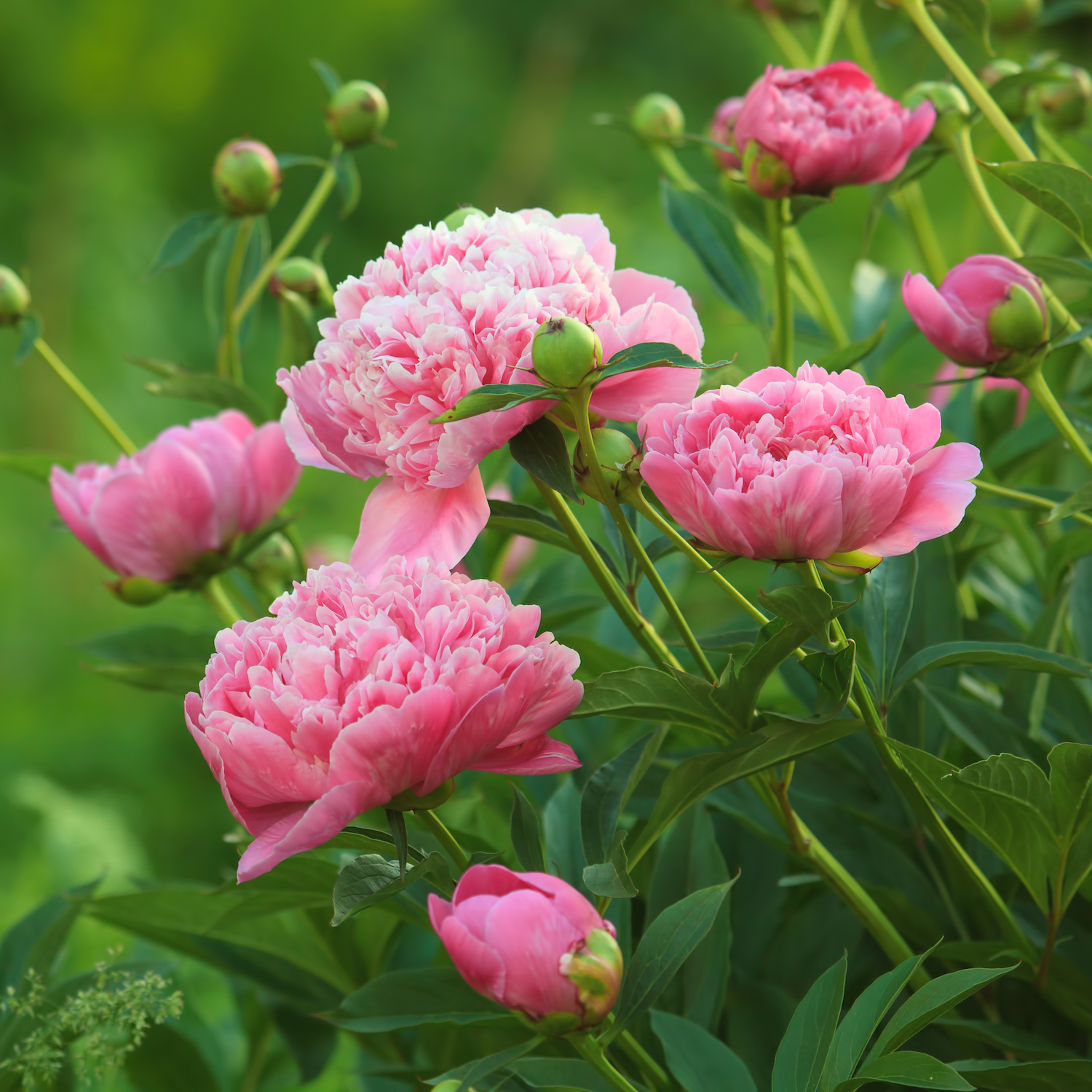Peonies are the spring-blooming stars of your garden. They have large, showy blooms and loads of personality. By some estimates, there are as many as 33 different species within the genus Paeonia, known collectively as peonies. Most are herbaceous perennials, though a few are woody shrubs. Peonies are medium-sized, have tuberous roots that are a combination of thick storage roots and thin roots that are designed to absorb water and nutrients. Careful handling of these roots is critical to planting or transplanting peonies, as well as when you are dividing plants to propagate them.
Slow-growing peonies are categorized in many different ways, such as by flower type or by growth habit. In addition to the familiar garden-variety herbaceous peonies with all their flower variations, there are special types such as fern-leaf peonies (Paeonia tenuifolia), a particularly sensitive and prized species, and tree peonies, which are woody, upright forms. These types have some special planting needs.
Japanese peonies (Paeonia japonica) are worthy of special mention as they are unlike other peonies in that they prefer part shade as opposed to full sun. These compact peonies are also relatively early-blooming, with a single bloom appearing in mid to late May.
Bloom time for peonies generally varies from late spring to late summer, depending on variety, but all types are best planted in the fall, about six weeks before the ground freezes. This gives the plant time to settle in and establish roots before winter. This is especially true when planting bare root peonies or when transplanting, but even when planting potted peonies, fall planting gives better results than spring planting.
Peony Care
Peonies are classic garden plants that can thrive for decades with minimal care when planted in a spot they like, in soil that meets their needs. One of the longest-lived of all garden plants, peonies are sometimes handed down from generation to generation in families. But it is very important to do the initial planting correctly because peonies can be temperamental about being moved once they are established.
Give each peony plant enough space to grow to maturity without being crowded. That means a 3- to 4-foot diameter for each plant. Choose a location that is sheltered from strong winds. Plant your peonies well away from other trees and shrubs, since they don’t like to compete for nutrients and water.
Peonies like a good chill in the winter. In order to set their flower buds, peony roots should be planted relatively close to the soil surface—only about 2-to 3-inches deep. It may feel odd to leave roots so exposed, but peonies actually need this chilling to attain dormancy and set buds.
Light
Except for Japanese peonies, all other types need a location that receives at least 6-hours of sun each day and a full day of sun is even better. Without sufficient sunlight, you’ll get fewer blooms and smaller flowers, and the plants will have a greater risk of fungal diseases.
Soil
Peonies are very adaptable, but ideally, they like a well-drained, slightly acidic soil (6.5-7.0 pH). If you are planting in heavy, clay soil, amending with compost or a soil mix labeled for azaleas and rhododendrons will make it easier for your peony plant to settle in. Since peonies can remain in the same spot for upwards of 70 years, taking the time to prepare the soil before planting is time well spent.
Tree peonies like a slightly more alkaline soil than standard herbaceous peonies, and they do not want to compete with other shrubs.
Water
Peonies need moist, well-drained soil to thrive. Ideally, they should receive 1 to 2 inches of water weekly. They can thrive in relatively wet areas but are not drought-resistant. Mulch your peonies to help them retain water and lessen the likelihood of weeds.
Temperature and Humidity
Peonies prefer cooler areas (hardiness zones 3-8) and do best when they experience cold winters.
Fertilizer
Feed lightly. An annual application of compost mixed with a very small amount of fertilizer around the base of the plant is all that is needed. When you do feed with compost and fertilizer, do it just after the plants have finished blooming.
Don’t smother peonies with mulch in winter. In the first winter season, you can mulch loosely with pine needles or shredded bark, but mulch should be promptly removed in spring.
Tree peonies need iron and phosphate and do well with an annual feeding of sulfate and bone meal in spring. Unlike herbaceous peonies, they need regular feeding with a 5-10-5 fertilizer.
Are Peonies Toxic?
All parts of peonies are poisonous to pets, livestock, and mildly to people, because they contain the toxin paeonol; it’s concentrated in the bark also found in small amounts in the flowers.
Symptoms of Poisoning
If people, pets, or livestock eat peonies, nausea, vomiting, or diarrhea may result. For animals, call your vet ASAP. In humans, it’s less worrisome, but do call poison control for advice.
Pruning
Peonies require little pruning. Once yours has finished blooming, cut back dead stems and branches. If a stem appears diseased, cut back before the affected part. If two branches rub against each other, remove the least desirable branch. When pruning peonies, always cut back to right above the first bud.
Propagating Peonies
Peonies are best propagated by lifting and dividing the root clump, then immediately replanting the divided pieces. A peony may require this after about 10 years when it begins to lose its vigor and becomes root-bound. Here, too, fall is the best time for this activity. Just before you plan to divide, cut the foliage of the peony back down to ground level.
Dig up the entire plant and remove as much soil as possible by soaking with a hose. Using your hands, manipulate the roots into dividable portions, each with 3-5 “eyes”—small reddish buds that resemble potato eyes—then use a sharp knife to cut the tuberous root-clump into divisions.
Cut away all the tiny roots on each division, leaving only the large, fleshy roots. Replant the divisions as soon as possible, following the instructions above.
Potting and Repotting Peonies
Peonies are typically purchased as potted plants in 1/2- or 1-gallon containers at the nursery or as bare roots, often packaged with peat moss or wood shavings in plastic bags. The peonies offered at plant society sales or plant swaps are very often the tuberous bare root varieties.
When choosing potted peonies, look for healthy specimens without leaf spots or weak-looking stems. When planting from bare tuberous roots, make sure the root clump has at least three to five eyes. These eyes will eventually elongate and become the plant’s stems. A mature peony should be at least three to four years old before it is divided into bare roots. Tuberous clumps with only one or two eyes may still grow, but they will take longer to become established plants.
If an established peony needs to be moved, transplanting should be done carefully to avoid disturbing the roots any more than necessary. These plants can thrive in the same spot for decades, but moving one hastily can bring about its demise. As with any planting, fall is the best time to move a peony.
At the new planting site, till up the soil 12-18 inches deep, and mix in a 4-inch layer of compost or peat moss. Water with 1-inch of water a day or two before transplanting. Your peony must be well hydrated before moving it.
Dig around the root ball of the peony using a sharp spade, getting as much soil as possible. Slide a tarp under the root ball to keep it intact, then lift the plant from the ground and carefully carry or slide it to the new location.
At the new location, dig a hole that is twice as wide as the peony’s root ball, and exactly as deep as the root ball. Plant the peony at exactly the same depth as it was in its old location. Backfill around the plant. Tamp the soil down with your hands, but do not pack it too tightly. Water thoroughly. Add a 3-inch layer of compost or mulch around the base of the plant. This will keep the roots moist and cool while the plant is establishing in its new location.
Common Pests/Diseases
Peonies are especially prone to gray mold (botrytis). To combat, make sure peonies are not planted too closely to each other, making sure air circulates between plants. Using copper soap fungicides can help as well.
By Marie Iannotti from thespruce.com








